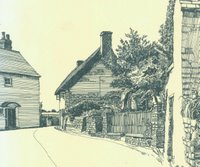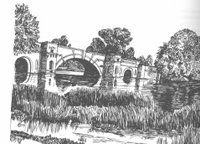the shift
"One day near the end of my first summer in Britain, while visiting Magdalen College, Oxford, the cumulative experience of recent walks, sights, senses, and ideas, the layering of efforts and disciplines that have made the landscape of southern Britain, became overwhelming. Many thousands of people before me have passed through this college and its environs and have been moved by its tranquil cloister, commenting on the charm of the river and bridge, the shady waterside path known as Addison's walk, and the harmony between Sir Christopher Wren's classical building and the earlier Gothic arcades and tower. On this particular occasion I happened to find myself at a corner of its little park beside the Wren building. It was a beautiful warm afternoon, and a small herd of fallow deer was browsing near the railing, their mottled tawny backs moving in and out of shadows cast by centuries-old oaks. It was calm and quiet. Birds chattered and cooed somewhere above. A bell chimed the hour. I studied Wren's graceful facade, the tall window frames and buttery-gray stone of the wall, their cornices, the central arcade, and the vines growing upon it. I turned and found the massive hulk of an ancient tree. Beneath it was a plaque. The text expalined that this plant had been opne of the first London plane trees to be grown in the seventeenth century in the botanical garden across the road from the college. They had been started from cuttings brought from the very first such plant in London, where specimens of Oriental planes and American sycamores had accidentally (naturally?) cross-pollinated in the nursery of a leading horticultralist who had been actively importing plants from around the world.
The tree and Wren's building were the same age. I thought about the effort and vision of the people who created this ensemble, the optimism and care with which they had attempted to combine the latest science of their day, in this case botany, and the exploration of distant continents with the accident that had produced this hybrid, which has been such a blessing for the great cities of the world ever since, and of architecture and planning--in this case Wren's use of the very latest and modern architectural style and technology to produce a bold and handsome building, one that holds its own with the equally strong (and contemporary in their own day) late Gothic buildings it faces, forming a court without rejecting them--and of the deer, themselves a remnant of medieval landholdings and hunting priveleges, not to say culinary habits. The trees, the animals, the buildings, the steady and serious scholarship inside, the light-hearted recreation on the river outside, together presented a clear attempt by the men of the seventeenth century who created this ensemble to produce a harmonious world through the combination of art and science, nature and culture. It isn't Utopia, but it is humane in the deepest sense of the world. Also it is beautiful. As I finished reading the plaque the intelligence and combined efforts that produced this ensemble struck me, and I burst into tears."
--Laurie Olin, Across the Open Field: Essays Drawn From English Landscapes

I am putting together a chart comparing the passions and dislikes of landscape architect Laurie Olin and Dave Hickey--born only a year apart (1939 and 1940, respectively), both successful practioners and critics of what falls in the broad categories of art and design, and both with such different, highly developed sensibilities and polar-opposite reactions to: the 1960s, French theory, popular culture. I can't imagine the young Dave Hickey bursting into tears for anything. Between Olin and Hickey lies the shift to postmodernism in American sensibility; I'm just not sure that I can tease it out.
On a similar note, I wish that someone had come up with the idea, in the 1980s when it was still relevent, to put Mary Gaitskill and Camille Paglia in a room together to chat.

"One day near the end of my first summer in Britain, while visiting Magdalen College, Oxford, the cumulative experience of recent walks, sights, senses, and ideas, the layering of efforts and disciplines that have made the landscape of southern Britain, became overwhelming. Many thousands of people before me have passed through this college and its environs and have been moved by its tranquil cloister, commenting on the charm of the river and bridge, the shady waterside path known as Addison's walk, and the harmony between Sir Christopher Wren's classical building and the earlier Gothic arcades and tower. On this particular occasion I happened to find myself at a corner of its little park beside the Wren building. It was a beautiful warm afternoon, and a small herd of fallow deer was browsing near the railing, their mottled tawny backs moving in and out of shadows cast by centuries-old oaks. It was calm and quiet. Birds chattered and cooed somewhere above. A bell chimed the hour. I studied Wren's graceful facade, the tall window frames and buttery-gray stone of the wall, their cornices, the central arcade, and the vines growing upon it. I turned and found the massive hulk of an ancient tree. Beneath it was a plaque. The text expalined that this plant had been opne of the first London plane trees to be grown in the seventeenth century in the botanical garden across the road from the college. They had been started from cuttings brought from the very first such plant in London, where specimens of Oriental planes and American sycamores had accidentally (naturally?) cross-pollinated in the nursery of a leading horticultralist who had been actively importing plants from around the world.
The tree and Wren's building were the same age. I thought about the effort and vision of the people who created this ensemble, the optimism and care with which they had attempted to combine the latest science of their day, in this case botany, and the exploration of distant continents with the accident that had produced this hybrid, which has been such a blessing for the great cities of the world ever since, and of architecture and planning--in this case Wren's use of the very latest and modern architectural style and technology to produce a bold and handsome building, one that holds its own with the equally strong (and contemporary in their own day) late Gothic buildings it faces, forming a court without rejecting them--and of the deer, themselves a remnant of medieval landholdings and hunting priveleges, not to say culinary habits. The trees, the animals, the buildings, the steady and serious scholarship inside, the light-hearted recreation on the river outside, together presented a clear attempt by the men of the seventeenth century who created this ensemble to produce a harmonious world through the combination of art and science, nature and culture. It isn't Utopia, but it is humane in the deepest sense of the world. Also it is beautiful. As I finished reading the plaque the intelligence and combined efforts that produced this ensemble struck me, and I burst into tears."
--Laurie Olin, Across the Open Field: Essays Drawn From English Landscapes

I am putting together a chart comparing the passions and dislikes of landscape architect Laurie Olin and Dave Hickey--born only a year apart (1939 and 1940, respectively), both successful practioners and critics of what falls in the broad categories of art and design, and both with such different, highly developed sensibilities and polar-opposite reactions to: the 1960s, French theory, popular culture. I can't imagine the young Dave Hickey bursting into tears for anything. Between Olin and Hickey lies the shift to postmodernism in American sensibility; I'm just not sure that I can tease it out.
On a similar note, I wish that someone had come up with the idea, in the 1980s when it was still relevent, to put Mary Gaitskill and Camille Paglia in a room together to chat.


0 Comments:
Post a Comment
<< Home